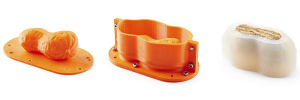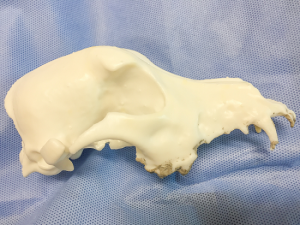In today’s 3D Printing News Briefs, we’re taking a look at some interesting use cases for 3D printing. First up, FATHOM is using DfAM to reduce the amount of material used in a mounting bracket, and students at the Lincoln Memorial University College of Veterinary Medicine are learning surgical skills with 3D printed models. Finally, a pastry world champion called on BCN3D for help in creating 3D printed molds for a unique dessert.
FATHOM Using Topology Optimization to Reduce Material
 Recently, Mechanical Engineer Alexei Samimi and Application Engineering Manager Tony Slavik of FATHOM showed off a practical application for the use of design for additive manufacturing (DfAM) in a featured blog post for the company. Using topology optimization, the two were able to reduce the material for a sub-assembly in a manufacturing facility’s service station by a total of 72%. The original volume of the part was 5.89 in3, and the two engineers turned to SOLIDWORKS and ANSYS software to lower that volume down to 1.66 in3 for the final part, which was 3D printed using HP’s Multi Jet Fusion technology.
Recently, Mechanical Engineer Alexei Samimi and Application Engineering Manager Tony Slavik of FATHOM showed off a practical application for the use of design for additive manufacturing (DfAM) in a featured blog post for the company. Using topology optimization, the two were able to reduce the material for a sub-assembly in a manufacturing facility’s service station by a total of 72%. The original volume of the part was 5.89 in3, and the two engineers turned to SOLIDWORKS and ANSYS software to lower that volume down to 1.66 in3 for the final part, which was 3D printed using HP’s Multi Jet Fusion technology.
“The goal in this example was to leverage topology optimization to minimize the weight of the bracket without compromising structural integrity,” the blog post states. “To fabricate this part, additive manufacturing is an ideal method of production because of the geometry, as well as the low-volume of parts required for this type of application (100 units). Multi Jet Fusion (MJF) is an ideal technology because its nearly isotropic material properties are suitable for topologically optimized parts, and nylon 12 would also satisfy the strength and impact specifications.”
FATHOM also offers a DfAM training program with custom curriculum that highlights topology optimization.
Using 3D Printed Models in Veterinary Education
Students at the Lincoln Memorial University-College of Veterinary Medicine (LMU-CVM) will soon have the chance to practice their surgical skills on 3D printed models, as the technology will be incorporated into an elective class offered to students starting next month. This past summer, LMU-CVM acquired two 3D printers, which makes it possible to use different types of materials for medical models. Since then, Dr. Jamie Perkins, a clinical skills veterinarian for the Center for Innovation in Veterinary Education and Technology (CIVET) at the university has been working to incorporate the technology into the curriculum, as it can be used to complete tasks such as 3D bioprinting and prosthetics research, creating equipment, supplies, and educational specimens in-house, and for both pre-operative and surgical training.
“Our students will be entering practices such as specialty surgical centers where they will use 3D printers in their surgical planning. Our goal is to prepare competent graduates that are ready to hit the ground running on day one after graduation. Knowledge of this technology will give our students a competitive edge as they enter the workforce,” said LMU-CVM Vice President and Dean Jason Johnson.
3D Printed Pastry Molds by BCN3D
 Pastry World Champion Jordi Bordas, who created the B·Concept recipe formulation method, was recently the subject of an interesting use case in collaboration with BCN3D Technologies. His last project involved a peanut-flavored product, called Peanut Gold, that was also shaped like a peanut. But Bordas and his team couldn’t find an existing mold for the pastry, and determined that they would need to make one themselves. He was inspired by Dinara Kasko, who had previously used 3D printed food molds, and contacted BCN3D for help creating a mold, using 3D printing, for his Peanut Gold.
Pastry World Champion Jordi Bordas, who created the B·Concept recipe formulation method, was recently the subject of an interesting use case in collaboration with BCN3D Technologies. His last project involved a peanut-flavored product, called Peanut Gold, that was also shaped like a peanut. But Bordas and his team couldn’t find an existing mold for the pastry, and determined that they would need to make one themselves. He was inspired by Dinara Kasko, who had previously used 3D printed food molds, and contacted BCN3D for help creating a mold, using 3D printing, for his Peanut Gold.
“There are some alternatives to make moulds for pastry, as creating master models or working with CNC machines, but they are more complicated to use and normally imply more costs,” the company wrote in a post. “With 3D printing, moulds can be done easily and with complex shapes, getting the best results.”
BCN3D suggested that Bordas use PLA to 3D print a peanut model on the proper scale to create the mold, and his team got to work. BCN3D then 3D printed the peanut in high resolution on its Sigma R19, using a 0.3 mm hotend for high quality, smooth details. Once the company completed the prototype, Bordas and his team were able to 3D print an external structure that could then be poured inside the liquid silicone and turn into the mold once it hardened.
Take a look at the 3D printing process and mold production in the time lapse video below:
Discuss these stories and other 3D printing topics at 3DPrintBoard.com or share your thoughts below.
Subscribe to Our Email Newsletter
Stay up-to-date on all the latest news from the 3D printing industry and receive information and offers from third party vendors.
Print Services
Upload your 3D Models and get them printed quickly and efficiently.
You May Also Like
The Market and Industry Potential of Multi-Material 3D and 4D Printing in Additive Electronics
Additive manufacturing leverages computer-based software to create components for products by depositing either dielectric or conductive materials, layer by layer, into different geometric shapes. Since its birth in the 1980s,...
3DPOD 262: Bio-inspired Design for AM with Dhruv Bhate, Arizona State University
Dhruv Bhate is an associate professor at Arizona State University. There, he looks at structures, materials, and design. Previously, he worked at PADT as well as in the semiconductor and...
3DPOD 261: Tooling and Cooling for AM with Jason Murphy, NXC MFG
Jason Murphy´s NXC MFG (Next Chapter Manufacturing) is not a generalist service; instead, the company specializes in making tooling. Using LPBF and binder jet, the company produces some of the...
3DPOD 260: John Hart on VulcanForms, MIT, Desktop Metal and More
John Hart is a Professor at MIT; he´s also the director of the Laboratory for Manufacturing and Productivity as well as the director of the Center for Advanced Production Technologies....

































